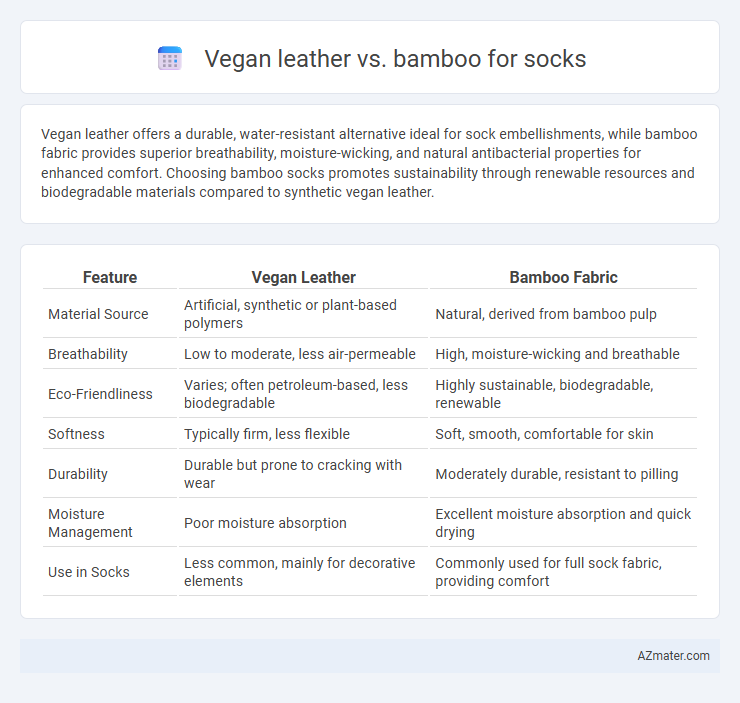Vegan leather offers a durable, water-resistant alternative ideal for sock embellishments, while bamboo fabric provides superior breathability, moisture-wicking, and natural antibacterial properties for enhanced comfort. Choosing bamboo socks promotes sustainability through renewable resources and biodegradable materials compared to synthetic vegan leather.
Table of Comparison
| Feature | Vegan Leather | Bamboo Fabric |
|---|---|---|
| Material Source | Artificial, synthetic or plant-based polymers | Natural, derived from bamboo pulp |
| Breathability | Low to moderate, less air-permeable | High, moisture-wicking and breathable |
| Eco-Friendliness | Varies; often petroleum-based, less biodegradable | Highly sustainable, biodegradable, renewable |
| Softness | Typically firm, less flexible | Soft, smooth, comfortable for skin |
| Durability | Durable but prone to cracking with wear | Moderately durable, resistant to pilling |
| Moisture Management | Poor moisture absorption | Excellent moisture absorption and quick drying |
| Use in Socks | Less common, mainly for decorative elements | Commonly used for full sock fabric, providing comfort |
Introduction to Sustainable Sock Materials
Vegan leather and bamboo represent innovative, eco-friendly materials used in sustainable sock production, offering alternatives to traditional cotton and synthetic fibers. Bamboo fibers are naturally antibacterial, moisture-wicking, and biodegradable, making them ideal for comfortable, breathable socks. Vegan leather, often crafted from plant-based sources like pineapple or apple waste, provides a durable, cruelty-free option for sock accents or reinforcements while minimizing plastic usage and environmental impact.
What is Vegan Leather?
Vegan leather is a synthetic or plant-based material designed to mimic traditional animal leather without using any animal products, often made from polyurethane or innovative sources like pineapple leaves and cork. This cruelty-free alternative offers durability, water resistance, and a variety of textures, making it suitable for sustainable fashion items including socks. Compared to bamboo fabric, which is naturally breathable and moisture-wicking, vegan leather provides a distinct aesthetic and protective qualities for specialty sock designs.
Understanding Bamboo Fabric
Bamboo fabric, derived from the pulp of bamboo grass, offers exceptional breathability, moisture-wicking properties, and natural antibacterial benefits, making it an ideal material for socks. Compared to vegan leather, which is primarily synthetic and less breathable, bamboo fabric provides superior comfort, softness, and sustainability through rapid renewability and biodegradability. Its eco-friendly cultivation requires minimal water and no pesticides, enhancing the environmental advantage over many traditional textile alternatives.
Environmental Impact: Vegan Leather vs Bamboo
Vegan leather, often made from polyurethane or PVC, has a higher carbon footprint and generates more non-biodegradable waste compared to bamboo, which is a rapidly renewable resource requiring minimal pesticides and water. Bamboo fibers are biodegradable and decompose naturally, reducing landfill impact, whereas synthetic vegan leather contributes to microplastic pollution. Choosing bamboo socks supports sustainable agriculture and lowers environmental degradation relative to conventional vegan leather alternatives.
Comfort and Breathability Comparison
Vegan leather socks offer a sleek appearance but tend to lack the breathability and moisture-wicking properties essential for prolonged comfort. Bamboo socks excel in softness and natural breathability, providing superior moisture absorption and temperature regulation that reduce odor and enhance all-day wearability. The eco-friendly bamboo fibers create a lightweight, cushioned feel, making them a preferred choice for comfort-focused footwear.
Durability and Longevity of Each Material
Vegan leather socks offer high durability due to their synthetic composition, often resisting wear and tear better than natural fibers. Bamboo socks provide excellent longevity thanks to their natural strength, moisture-wicking properties, and resistance to odor and bacteria growth. Both materials ensure long-lasting performance, but vegan leather excels in abrasion resistance while bamboo prioritizes comfort and breathability over extended use.
Production Process: Vegan Leather vs Bamboo Socks
The production process for vegan leather socks involves synthetic materials such as polyurethane, crafted through chemical treatments and coating techniques to mimic traditional leather's texture and durability. Bamboo socks are created using natural bamboo fibers, which undergo mechanical or chemical processes like viscose production to convert raw bamboo into soft, breathable yarn suitable for textile manufacturing. While vegan leather emphasizes a synthetic, eco-friendlier alternative to animal leather, bamboo socks prioritize sustainability through renewable plant-based resources and biodegradability.
Cost Differences and Market Trends
Vegan leather socks generally cost more than bamboo socks due to the intricate manufacturing process and synthetic materials involved, whereas bamboo socks are more affordable as they utilize naturally abundant, sustainable fibers. Market trends indicate growing consumer preference for bamboo socks driven by eco-friendliness and breathability, while vegan leather socks appeal to fashion-forward buyers seeking cruelty-free alternatives with a leather-like aesthetic. Sales data reveal rapid expansion in bamboo sock demand within sustainable apparel segments, whereas vegan leather socks maintain steady growth niche markets.
Style, Design, and Versatility
Vegan leather socks offer a sleek, contemporary style with a smooth texture that mimics traditional leather, ideal for fashion-forward designs and urban outfits. Bamboo socks provide a soft, breathable fabric with natural moisture-wicking properties, combining comfort with eco-friendly versatility suitable for casual and athletic wear. Both materials allow for diverse design options, but vegan leather emphasizes bold, structured aesthetics while bamboo highlights flexibility and everyday comfort.
Which is Better for Socks: Vegan Leather or Bamboo?
Bamboo sock fabric offers superior breathability, moisture-wicking properties, and natural antibacterial benefits compared to vegan leather, making it more comfortable and hygienic for daily wear. Vegan leather, made from synthetic or plant-based materials, provides durability and a stylish appearance but lacks the softness and flexibility essential for socks. For socks, bamboo is better due to its softness, sustainability, and comfort-enhancing qualities.

Infographic: Vegan leather vs Bamboo for Sock
 azmater.com
azmater.com